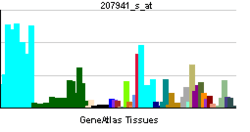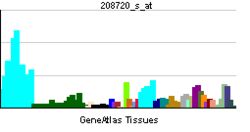RBM39
RNA-binding protein 39 is a protein that in humans is encoded by the RBM39 gene.[3][4]
Function
The protein encoded by this gene is an RNA binding protein and possible splicing factor. The encoded protein is found in the nucleus, where it colocalizes with core spliceosomal proteins. Studies of a mouse protein with high sequence similarity to this protein suggest that this protein may act as a transcriptional coactivator for JUN/AP-1 and estrogen receptors. Multiple transcript variants encoding different isoforms have been observed for this gene.[4]
Interactions
RBM39 has been shown to interact with Estrogen receptor alpha,[5] Estrogen receptor beta[5] and C-jun.[5]
References
Further reading
- Jung DJ, Na SY, Na DS, Lee JW (2002). "Molecular cloning and characterization of CAPER, a novel coactivator of activating protein-1 and estrogen receptors". J. Biol. Chem. 277 (2): 1229–34. doi:10.1074/jbc.M110417200. PMID 11704680.
- Lehner B, Semple JI, Brown SE, Counsell D, Campbell RD, Sanderson CM (2004). "Analysis of a high-throughput yeast two-hybrid system and its use to predict the function of intracellular proteins encoded within the human MHC class III region". Genomics. 83 (1): 153–67. doi:10.1016/S0888-7543(03)00235-0. PMID 14667819.
- Andersen JS, Lam YW, Leung AK, Ong SE, Lyon CE, Lamond AI, Mann M (2005). "Nucleolar proteome dynamics". Nature. 433 (7021): 77–83. doi:10.1038/nature03207. PMID 15635413.
- Dowhan DH, Hong EP, Auboeuf D, Dennis AP, Wilson MM, Berget SM, O'Malley BW (2005). "Steroid hormone receptor coactivation and alternative RNA splicing by U2AF65-related proteins CAPERalpha and CAPERbeta". Mol. Cell. 17 (3): 429–39. doi:10.1016/j.molcel.2004.12.025. PMID 15694343.
- Sun NN, Fastje CD, Wong SS, Sheppard PR, Macdonald SJ, Ridenour G, Hyde JD, Witten ML (2005). "Dose-dependent transcriptome changes by metal ores on a human acute lymphoblastic leukemia cell line". Toxicology and industrial health. 19 (7–10): 157–63. doi:10.1191/0748233703th185oa. PMID 15747776.
- Olsen JV, Blagoev B, Gnad F, Macek B, Kumar C, Mortensen P, Mann M (2006). "Global, in vivo, and site-specific phosphorylation dynamics in signaling networks". Cell. 127 (3): 635–48. doi:10.1016/j.cell.2006.09.026. PMID 17081983.
PDB gallery |
|---|
|
| 2cq4: solution structure of RNA binding domain in RNA binding motif protein 23 |
|
|



 . PMID 8227358.
. PMID 8227358.